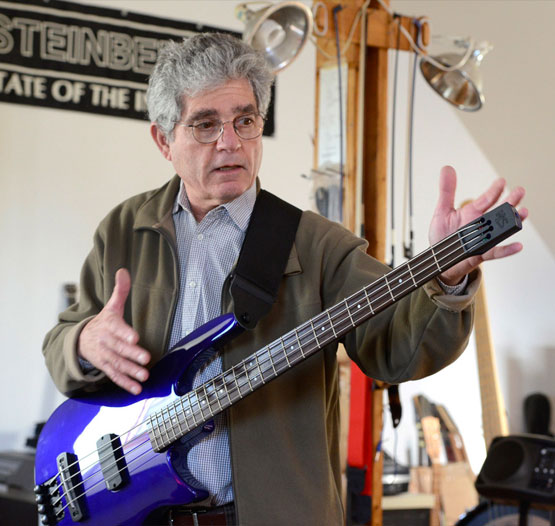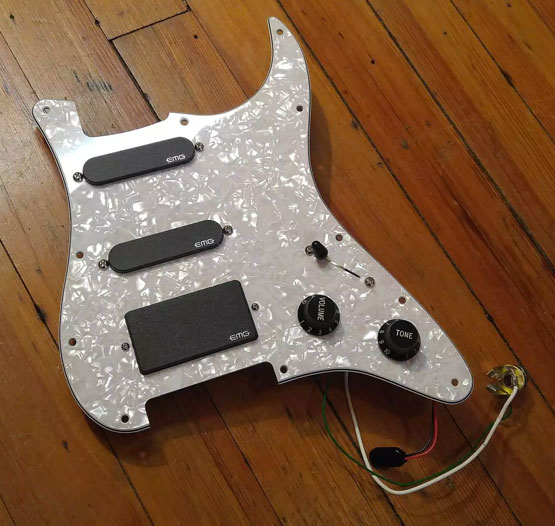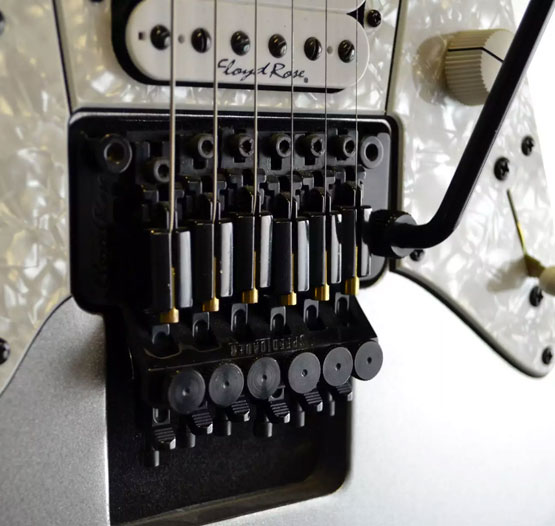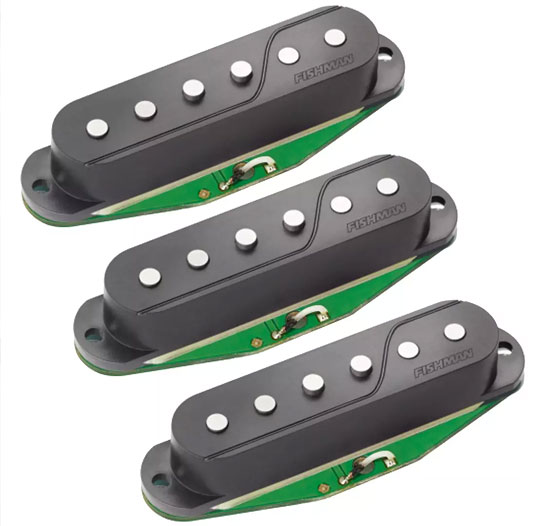The guitar industry is a tough business. Players’ tastes are subjective and constantly changing – they want gear with better playability, but they’re reluctant to divorce from tradition. Manufacturers are working hard to deliver, but oftentimes reissues of vintage gear end up more popular than their brand new designs.
This begs the question – why is it so challenging to be successfully innovative in the guitar industry? I spoke with a few people at the epicenter of the electric guitar design market, each with a unique answer about the difficulties of innovating and their rationale for continuing to forge ahead in a sometimes hostile climate.
Ken Parker
Ken Parker’s major innovation was the radical Fly Guitar, which was the vision he shared with Larry Fishman. The Fly guitar was one of the first guitars to feature locking tuners, GraphTech nuts, hardtailing-vibrato systems, piezo and electric pickups, and stainless steel frets. Its most innovative feature was the epoxy exoskeleton, which allowed the guitar have to have an incredibly sculpted neck joint.

Parker was candid in his comments on innovation and the struggle that faces the designer. When asked about the trouble innovating in the industry, Parker pointed out that it wasn’t the industry that made it difficult to innovate, but the age-old unwillingness of the players to try something new.
“When the Fender Bass first came out, session players who listed it on their business cards would be excommunicated from some groups of upright players who wanted nothing to do with them. Today, of course, that’s hard to imagine.”
While Parker had the foresight to be on the cutting edge of guitar technology, he still understood the reluctance of guitar players, too. In 1990, he was a part of a well-made but complex MIDI guitar project. The project’s designer asked Parker at NAMM how many units Parker thought they would sell. Parker replied, “About a few thousand.” The designer shot back, “We’ll be selling hundreds of thousands!” The project went on to lose a million dollars.
“Guitar players want simplicity,” Parker stated. “They want 3-4 knobs, only a few choices. Once you get past one or two choices, their eyes glaze over. More than three choices, and you’ve lost them.”
"Guitar players want simplicity. They want 3-4 knobs, only a few choices. Once you get past one or two choices, their eyes glaze over. More than three choices, and you’ve lost them."
Parker says that innovation in the guitar industry is really driven and accepted by the tiny minority of professional players at their creative peak. “Leo Fender was listening to players around him and was responding to their needs.” Parker continued, “The player at the edge of their ability and top of their game, maybe 1% of players, are willing to embrace innovation. If a player is happy, they’re reluctant to change. That 1 in 7 player who has the ability and obsession to push limits and ‘gets it’ – they are the ones you can seduce.”
Parker concedes that it’s hard to be “usefully innovative” when many of the older instruments were well designed. But he also acknowledges that there’s always a place for new ideas. The only question that you have to ask yourself when making something new, Parker says, is “does it make better music?”
Ned Steinberger
Ned Steinberger came to instrument design not from the repair or music world, but from furniture design. When Stuart Spector asked him to design a bass, his completely unique sense of thinking reformed nearly every aspect of the instrument.
“You have to come in with an open and critical mind,” Steinberger relayed, regarding his philosophy. “It’s not about recognition. You need to come up with ideas that are actually innovative. It’s about vision and solving a problem in a meaningful way.”

Steinberger was successful with his bass design because he tackled two huge problems: balance and ergonomics. But even though he was tackling specific design flaws, he was still getting resistance from players. “I was able to overcome the hurdles with bass. The innovation was self-evident – you could not argue that what I was doing wasn’t logical. Still, only a small percentage of players were interested.”
Jack Westheimer, pioneer of the global guitar world and Steinberger’s personal friend, put things into perspective for him. He told Steinberger that the guitar market is a “perfume market” that’s “all about fashion.” Steinberger says that he was younger at the time and vehemently disagreed – he didn’t want to be fashionable.
But Jack was right, and eventually Steinberger’s designs did become fashionable. “People were interested in innovation and ‘high-tech’ [in the ‘80s]. Our design worked very well, was well-made, had features that no other instruments had, and had a certain style to them.”
In a market where players are tied to tradition, though, it’s difficult to forge a career. Steinberger felt the pressure of players’ desire for vintage, which led to offering full-sized bodies on later instruments. “I was concerned with function, not with what people were used to. The headless design is an evolution. It was my own design fantasy. Now, at this stage, I try and make functional advances and to respect traditions without trying to bury those [players’] feelings.”
Steinberger believes that the vintage craze will eventually wane and that new technology will be embraced soon. “The guitar players of the past were pioneers, pushing the frontier. But electric guitar is no longer new and different, that [first] trailblazing era is over.” With the rise of extended range guitars, the resurgence of headless design, and innovative electronics gaining ground, Steinberger may be right that high tech instruments will be embraced again.
EMG
Perhaps the most successful departure from 1950s guitar technology has been EMG pickups. Scott Wunschel, National Sales Manager for EMG, explained that only over the last 10 years have their innovative pickups been considered "mainstream" despite their 40 year history.

EMG’s success is largely a result of the popularity of metal bringing new players looking to follow the new iconoclastic breed of guitar heros like a Zakk Wylde, Kirk Hammett, and Kerry King into the market. But despite their success, EMG still struggles to expand beyond the metal market, as some players don’t realize that they have been making passive and vintage voiced pickups for 40 years.
Wunschel says that being pigeonholed is a reality of making pickups. “[Seymour] Duncan was associated with the Fender sound, Dimarzio with the Gibson sound – we were trying to be something different." Wunschel continues, “It’s tough to change opinions, but it goes both ways. Duncan tried to take our market with their Livewires pickups and spent tons of money on marketing. But our reputation in the market overshadowed theirs, and that project just faded into their line.”
Wunschel thinks that new guitar heros are what’s needed to bring more players into the market, and those players will be less afraid of new technology. Style is another way to bring new players into the fold. “We introduced the Metal Works series, which added a new look and renewed interest in the pickups...we were no longer just 'the black pickup.'”
Wunschel says that these changes help encourage new makers to adopt products, which also expands the market for innovation. He said EMG will continue to innovate. Their highly regarded banjo pickups, for example, are about as far removed as one can get from the metal world.
Floyd Rose
Floyd Rose is one of the most successful innovators of guitar technology since Fender and McCarty. Their brand has been synonymous with bridge systems for over 20 years. No single vibrato bridge design is featured on more different brands, from budget to boutique. With the advent of the guitar heroics of the 1980s, the expanded range and tuning stability of Rose’s double-locking vibrato system has become the standard.
"If you do come up with a fix for a problem, it will necessarily change something about the guitar that guitarists may be uncomfortable with for reasons real or imagined, and thus, will doom the innovation to failure."
Even with all of this success, Rose still finds that guitarists are conservative when it comes to their instruments. “In my experience, innovating in the guitar industry is difficult because, first, the functional issues that guitars have are difficult to fix. If you do come up with a fix for a problem, it will necessarily change something about the guitar that guitarists may be uncomfortable with for reasons real or imagined, and thus, will doom the innovation to failure in the marketplace.”
Floyd Rose’s SpeedLoader Bridge is an example of a such failed innovation.
“This bridge came about to improve on my double-locking tremolo system by eliminating the need for allen wrenches to lock and unlock the strings. My solution was to make strings with bullets on both ends of the string, similar to the Steinberger strings, except that each of my SpeedLoader strings were cut to a very precise length. This allowed strings to be replaced in seconds and the new string would be within about a half turn on the fine tuner screw from being in perfect tune. What could be wrong with that? It turned out that the bridge was rejected by most guitarists for a few reasons.”

One of those reasons was because the strings were not available in common brands (Ernie Ball, D’Addario, etc.) that the guitarists were used to playing. Another was because initially setting up and using the bridge required some education which, in 2004, was harder to access than it would be today. Because these bridges weren’t ubiquitous yet, the guitarists were also worried about future availability. So, the new bridge failed.
Despite this setback, Rose still keeps innovating. “I still see solving problems as a fun challenge. My most recent bridge, the FRX, makes putting a Floyd Rose tremolo on Gibsons easy. Installing the bridge requires no modifications to the body and only two small screw holes in the neck. This bridge seems to have solved a long-standing problem and is being well accepted, so I guess it is still possible to innovate successfully in 2016.” This bridge has been installed at the Gibson factory for a few limited runs.
Rose also will be innovating outside of his vibrato systems: “I will be introducing a new double-locking fixed bridge soon. I find that many guitarists love the way the Original Floyd keeps the guitar in perfect tune for weeks at a time while adding sustain to the guitar but hardly ever use a tremolo anymore due to the change in music styles. This bridge will fill that need.”
Frank Falbo of Fishman knows the difficulties in innovating well. Larry Fishman has been in the guitar technology business for 35 years, making acoustic pickups, amps, and other sound gear. Frank Falbo joined Fishman from Seymour Duncan a few years ago to work on the Fluence pickup project – a multi-voice pickup that is the “idealized” version of classic and modern humbuckers and single coils.

“We [at Fishman] really looked at many of the past introductions of new products when releasing the Fluence line,” Falbo said. “We wanted to introduce this brand new technology that would appeal to a wide array of players without instantly making it a dealbreaker.”
Falbo continued, “We knew that it would take time. We knew that the fact that it required a battery would be an issue for some players, for instance. But because Fluence does something, it requires power. Think of how many pedals you pass through – it's the same idea.”
Falbo also notes that marketing plays a big role when it comes to releasing innovative gear. He cites the Gibson USA 2015 line as an example of new releases with an overwhelming array of new features. The innovations will appeal to some and not to others, and one disliked innovation could sour the player on the entire suite of new offerings. A successful marketing plan can help to make those new features accessible to players.
Falbo elaborated that for his work, he likes to focus on one innovation at a time, making the wheel better rather than reinventing it entirely. This keeps things familiar for the player.
"They are introducing small but meaningful improvements, which is allowing guitar players to focus on the innovation and apply it to their own sound. This is the key to success in this paradoxical industry."
Fishman and Falbo strive for a “comfortable coexistence of vintage and modern.” This is best shown by their creative battery packs that replace standard control cover plates with no modification. “We needed elegant solutions. We were building answers to objections we knew we would have,” Falbo explained. “We see the future as idealized analog technology. Actually, Fluence delivers the analog electrons earlier than traditional pickups. You actually hear the notes faster.”
The path of innovation has been careful and deliberate. They are learning from the past issues of previous innovations and are introducing small but meaningful improvements, which is allowing guitar players to focus on the innovation and apply it to their own sound. This is the key to success in this paradoxical industry.
Solving the Problem
In all, the gear manufacturers are innovating. But are we, as players, showing up to the party? By remaining unwilling to try something new, we’re preventing the success of developments that we yearn for – the ones that would improve our tone, our playing, and and our overall experience.
A useful innovation made to better the industry is difficult in and of itself, and every innovation should be tested on a case-by-case basis. But by becoming a little more open and a little less conservative, players might just open themselves up to the next big thing – what could become the "classic" design of tomorrow.
